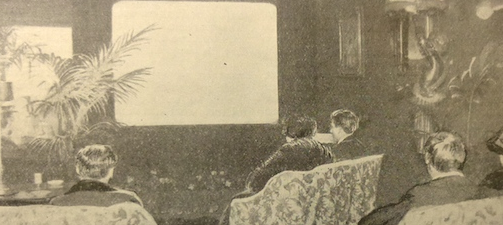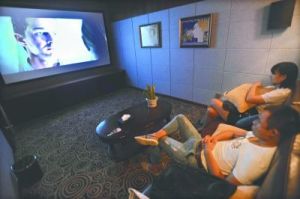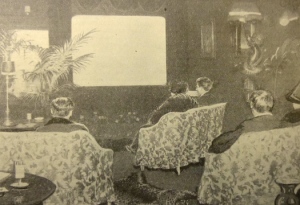I’ve been doing some research into the history of trade showrooms lately – the places where film companies give screenings to potential customers – and thinking a bit about the difference between watching a film in a public space and watching it in private. So I was interested to read this news item on a Chinese website (the wonders of Twitter) about a new chain of on-demand private cinemas being rolled out across various cities in China.
As far as I can make out, the cinemas offer a choice of rooms (a children’s room, a ‘courtship’ room), waiter service, comfy chairs and a choice of films accessed through a large touchscreen TV. I’m reliably informed that, so far, places like this in China are associated with the young, the wealthy and with special occasions – although this new chain seems to be offering more modest prices.
I’m sure this isn’t a new idea. In fact, I know it isn’t, because something like this was already being dreamt up in 1919 in London. The ‘drawing room’ cinema (pictured at the top of the post) was an innovation of Granger’s Exclusives, who had offices at the Oxford Street end of Wardour Street in Soho. Granger’s was a rental firm founded by A.G. Granger towards the end of the First World War, with a pro-British mission to distribute homegrown films. In 1919, the Kinematograph and Lantern Weekly announced the layout of the company’s new private screening space in their Wardour Street premises.
It is a drawing room with a screen within it. Even the operating box is hidden under an artistic camouflage which adds to the picturesqueness and the sense of refinement and repose which dominate the whole place. […] Its comfort and surroundings have given just that correct atmosphere which is essential if pictures are to be viewed properly.
Presumably, ‘proper’ viewing here means viewing without distractions, in a tasteful atmosphere, or whatever was most conducive to selling the film. But the article goes on to suggest ways that the spirit of the Granger Drawing Room Kinema might be extended to other commercial settings. Arthur Backner, the showroom’s designer, believed that the idea could be put into practice across London, or ‘in any centre of population where an elite clientele can be gathered together’.
A drawing-room cinema with some fifty or sixty people in it who were prepared to pay for the privileges of refinement and seclusion (and large numbers of people would do so, in his opinion), would be as distinct a novelty as it would be a success.
I’m not sure if Backner had ever reckoned with the local cinematograph licensing laws or with the economies of scale that shaped film exhibition elsewhere in London, and which would surely have put a dampener on his plans. But the idea, at least, was prescient – right down to the waiter service and the customised selection of films.
Afternoon tea could be served in the drawing room kinema, with pictures chosen specially for people who wanted that something in kinematography which was in exact keeping with their surroundings.
The public would have to wait a while for private cinemas along these lines. But the article does predict some developments which would actually happen within a few years, including the emergence of specialist, ‘high-class kinema clubs’.
Now that the cult of the kinema is becoming one of Society’s functions, there is no reason why clubs for the seeing of certain types of pictures should not be formed amongst enthusiasts – say the filming of novels, the viewing of social propaganda films, or any other subject of great public interest. Such pictures, which distinct sections of the community might wish to see under ideal conditions, could easily form the basis of picture clubs, whose rendezvous would most assuredly have to be in some such place as this Granger Drawing Room Kinema.
The article was half right. When the London Film Society was founded in 1925 as a private subscription club for the appreciation of film as art, it would meet in regular (though top-end) cinemas, rather than secluded ‘drawing room’ theatres like Granger’s. But the Film Society, and other groups like it, certainly pursued the aim of refinement in cinema-going, and kept alive the interest in finding the ‘ideal’ conditions for watching films that is evidently still being explored today.
References:
- ‘Arthur Backner’s Ideal Theatre’, Kinematograph and Lantern Weekly (6 March 1919): 77.
- Rachael Low, The History of the British Film, 1918-1929 (London: Allen & Unwin, 1971), p. 72.



